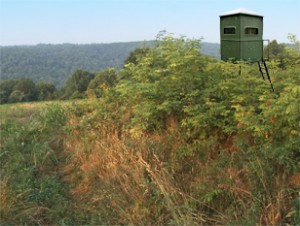Locating Deer Blinds
Filed under: Hunting Blog, Hunting Tactics
I was in Kentucky the past couple of days working on a property that a client is purchasing. The property has the potential to produce quality deer. However, producing and harvesting are two different tasks. To do both on a sustained basis requires planning and skill. The property has multiple openings that my client will use for food plots. Even though we are currently spraying, fertilizing, and planting these plots, it’s also time to think about hunting them. It’s only mid June, but it’s time to position elevated blinds to optimize the opportunity to observe and harvest white-tailed deer. Properly positioned elevated blinds help conceal a hunter’s movement and reduce scent dispersal.
Elevated blinds at some hunting properties I visit are positioned such that it appears the only criterion used to position those blinds was being as close as possible to the plot’s entrance. Although it is possible hunters have experienced success from these blinds, I suspect they would have had more success if the blind had been located based on some simple criteria including;
- Conditions that allow the hunter to approach the stand without being smelled, heard, or seen by deer.
- The likelihood that a hunter can remain undetected by deer while in the stand under specific wind directions, etc.
- The ability of the hunter to leave the stand after the hunt without alerting deer.
These seem like simple criteria to consider when placing an elevated blind. However, locating a blind in a position that increases a hunter’s opportunity to observe and harvest mature bucks on a sustained basis can require a lot of thought. Such stands should be placed during the early to mid summer so deer can become conditioned to the new structure in their living room! Deer, especially mature deer, are often alerted by new fixtures in their territory. Fortunately deer become conditioned to stationary objects within a few weeks unless additional disturbances are associated with the object.
When scouting for a location to place a blind, it’s very important to consider the conditions that will be prevalent when the blind will be used. In many regions the predominate wind direction shifts from a southerly to a northerly direction from the summer months to mid to late fall. If a hunter’s plans include hunting the blind more in the early season compared to the late season, it may be best to place the blind for a southerly wind. Often, the best bet is to place the blind on the eastern side of the area to be hunted. Winds from the east are often rare in many areas of the whitetails’ range.
It’s just as important to consider how hunters will approach the stand without alerting deer. This often means developing a walking trail to the blind other than the road that is normally used to access the plot. This task takes a bit more work, but is well worth the effort as it can substantially increase the opportunity to observe deer from the blind.
Likewise, it’s important to consider where the deer will likely be when each hunt (morning or evening) is concluded so the hunter can leave the blind without alerting deer and conditioning them to associate the blind with danger.
If multiple blinds are to be placed, consider the time of year each will be used and the factors that will impact deer movement at that time of year. These conditions include the harvest of crops, areas that deer bed at that time of year (north slopes during summer, southern slopes during winter conditions), etc.
Each property has unique conditions that should be considered when selecting where to place elevated blinds. Take the time to consider the many aspects that impact the likelihood of observing deer on a repeated basis from an elevated blind. By doing so you can add substantial enjoyment when hunting that location! Now is prime time to do the mental and physical exercises of placing elevated blinds!
Growing Deer together,
Grant



